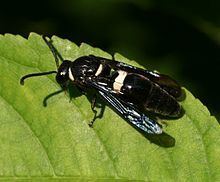Genus Monobia Rank Species | ||
 | ||
Similar Monobia, Euodynerus, Toxomerus geminatus, Toxomerus marginatus, Eumenes fraternus | ||
Monobia quadridens is a species of solitary potter wasp found in North America. It grows to a wingspan of 18 millimetres (0.71 in), and feeds on small caterpillars and pollen. There are two generations per year, with one generation overwintering as pupae.
Contents
- The carpenter wasp monobia quadridens
- Description
- Distribution
- Life cycle and ecology
- Sting
- Taxonomy
- References
The carpenter wasp monobia quadridens
Description
The abdomen of M. quadridens is entirely black, except for a broad ivory-coloured band on the first tergite. The wingspan is typically 11–14.5 millimetres (0.43–0.57 in) for males, and 14–18 mm (0.55–0.71 in) for females. It closely resembles Euodynerus bidens in size and colouration.
Distribution
Monobia quadridens has a wide distribution in eastern North America. In Mexico, it is found in the states of Tamaulipas and Nuevo León, while in the United States, it is found from New Mexico, Kansas and Wisconsin east to the Eastern Seaboard. The occurrence of the species in Canada has not been explicitly recorded in print, but specimens identified as M. quadridens have been present in Canadian entomological collections for a long time.
Life cycle and ecology
Monobia quadridens is bivoltine, having two generations in a year. One emerges in summer, while the other overwinters as a pupa before emerging the following spring. Copulation lasts for 30 minutes in M. quadridens, while in most wasp species, it only lasts a minute or two. It nests in a variety of cavities including tunnels abandoned by carpenter bees, old mud dauber nests and hollow plant stems.
The diet of M. quadridens is primarily composed of caterpillars of microlepidoptera, including species from the families Pyralidae, Crambidae, Elachistidae, Amphisbatidae, Gelechiidae and Tortricidae. The diet also includes a large proportion of pollen.
Sting
Like many wasps, Monobia quadridens is capable of delivering a sting. The pain caused by the sting of a female is similar to that caused by the bald-faced hornet or the ant Myrmecia nigripes. Unlike most other wasps, however, the male is also capable of delivering a painful sting like a needle prick, although no venom is injected, so the pain is transient. The male has no stinger and uses the tip of its abdomen.
Taxonomy
Monobia quadridens was first described by Carl Linnaeus in his 1763 work Centuria Insectorum, under the name Vespa quadridens.
